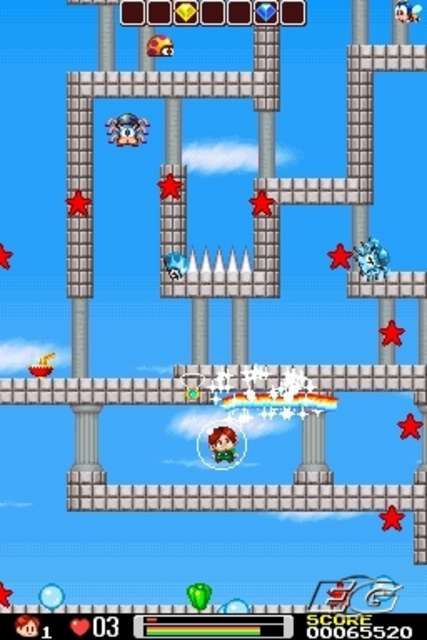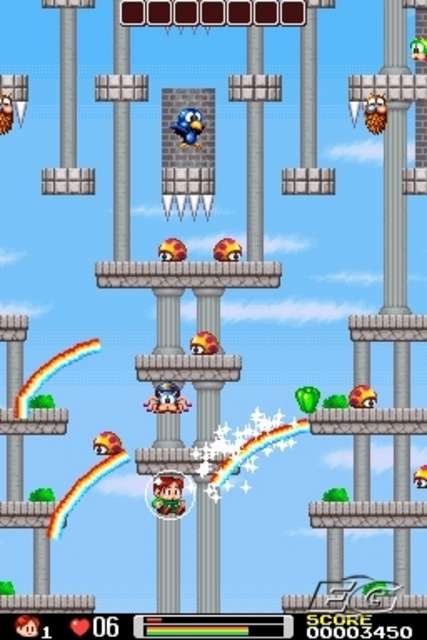Rainbow Islands Revolution
Crock of old.
That the Dreams development studio (the one set up by Space Invaders creator Tomohiro Nishikado) chooses to dust off Taito classics appears to be some sort of curiously sadistic plan to reinvent enduring properties and crush all of our hopes, dreams and memories in the process. Since it all kicked off last summer with Space Invaders Revolution, it's been a head-scratching, harrowing, depressing exercise in grave-robbing that seems to miss the point entirely. Both the Space Invaders and Bubble Bobble remakes were about as far from 'revolutionary' as you could possibly imagine - and the 2/10 spankings we dished out to both were being kind.
You can't blame Dreams for trying to mine Taito's rich seam of past glories, though, especially when the DS' touch-screen affords the developers new opportunities to dust off classic ideas and reinvent them with a new twist. But, as we've seen so many times in the past 18 months, the touch-screen can be as much of a curse as it is a blessing. Being able to move things around on screen and draw lines with a stylus does not automatically make something more fun. Indeed, for every stroke of genius, there are another five that seem to complicate things, often spoiling pure ideas and concepts with novelty or redundancy.
Even so, we greeted Rainbow Islands with optimism. Despite its track record, it was hard to imagine how Dreams could cock this one up. Let's see how they did.
The colour of fun
It's impossible to forget what a bona-fide platforming classic the 1987 original was. If you've somehow managed to avoid the Bub and Bob masterpiece in the intervening 19 years, it couldn't really be much simpler and yet still bears close scrutiny even now. Once again starring Bub and Bob (free of the dinosaur curse, it seems), the idea was to work your way up to the top of a vertical-scrolling level avoiding the numerous roaming monsters, zapping them with your rainbow attack and traversing the many platforms - not to mentions the same rainbows that also operated as makeshift platforms. In common with Bubble Bobble, the array of random tat that spewed forth from downed enemies helped players gain temporary power-ups, and part of the fun was finding out what the collectables actually did. Some gave you double (or even triple) rainbows, others made you run faster, and some just gave you a mega point bonus. Some... well, we wouldn't want to spoil the fun.
Unlike Bubble Bobble (and latterly Parasol Stars) you couldn't play the game in co-op mode (still a novelty at the time), so you couldn't work your way through the dozens of levels and tackle the many bosses with a pal. Ripping off the rose-tinted specs, of course, it's extremely dated now (i.e. its waaaaay tougher than most contemporary platformers and therefore quite frustrating), but there's a purity of vision that still shines through more than other so-called classics. Plus it's got that theme tune. Suddenly I am a teenager again, full of hope that one day I'll own a machine with a disk drive. (And then suddenly my 14-week-old son screams from the other side of the room and normality is restored, but the tune plays on. Yes! The tune is back!)
On the surface, the premise for Rainbow Islands Revolution looks almost unchanged, but don't be fooled. Rather than simply firing out rainbows in predefined arcs, the onus is now on you to physically draw them yourself. This allows you to effectively scrub out enemies anywhere on the touch-screen - even the ones that you shouldn't be able to reach, and much of the game involves basically drawing quick lines through them to reduce them to some sort of collectible.
Refreshed

The movement of Bub (or Bob - or indeed the two unlockable characters) also depends entirely on the touch-screen, with the nib of the stylus required to drag your bubble-encased character around the play area. The role of the rainbows no longer extends to providing makeshift platforms for them, and as a result the jump mechanic is scrapped too, so the whole game feels completely different. Although it's a bit weird at the outset, a few levels in it starts to feel completely natural to zap enemies with rainbows and guide your character around with the stylus. It's like platforming buzz-bar style.
With much of the movement altered so dramatically, the design of the levels has been completely overhauled too. Much of the emphasis is now on paying close attention to the direction of floating air bubbles, which give you a clue to the direction the wind, allowing you to avoid being dragged into the many spiked hazards that line the platforms and drain your stock of lives. If you're not careful you can easily find yourself paying too much attention to scrubbing out enemies, and fail to notice the fact that your man is being sucked along into the spiked death trap. As a result, the endless failure teaches you to plan your route, take your time and find somewhere where you can keep still and yet still strike your procession of foes. Inevitably, the time limit forces you to take a few risks along the way, but each of the four levels on each of the seven main islands is short enough to ensure that you'll want to play through again.
One of the best design decisions is to allow you to take six hits before you lose a life, making it quite a bit easier than the old-style Rainbow Islands, but much more playable in the long term. You can also top up your heart meter along the way if you're lucky, and there are unlimited continues to ensure you'll be able to romp through in a matter of a few hours. But you could say the same thing about the original, too.
Dragged to your doom

However, that doesn't mean you won't curse like crazy at times, thanks to some curious design decisions that make you want to throw the DS into the nearest bush. The nearest bush filled with lions. The biggest culprit is the air flow on each level. It's an absolute lottery sometimes, constantly dragging your hapless character into obstacles and causing crucial loss of life at the most inappropriate times. The little air bubbles are supposedly there to tell you the direction of the wind, but even after several hours of play it didn't make much sense.
Another unnecessary annoyance is the way that enemies have a tendency to flit from the upper screen to the lower screen without warning. Normally this wouldn't be an issue, but because your rainbow can only take out enemies on the lower portion, there's always a risk of being caught off guard when they decide to swoop down to the lower screen as you ascend. Trying to simply swat them away with frantic swipes only gets you so far; you soon find that more often than not you'll get swept away by an unforeseen air current the second you take your stylus off your character. After a while you make provisions for this and make damned sure to clear anything that even vaguely threatens to swoop down suddenly, and seek out 'safe zones' where you can 'park', but it takes a fair bit of trial and error to suss that out.
Even then, this won't necessarily prepare you for the arrival of the side-scrolling levels that almost entirely abandon the principle of the dual screen and manage to introduce new design quirks, such as off-screen enemies that lob bombs without warning - a ludicrously unfair obstacle. Stranger still during these levels, the upper screen is almost completely redundant, which makes you wonder why it's used at all. At least when the levels scroll vertically you can see what's coming - the horizontal levels make much of the negotiation a chance-ridden exercise in blind luck.
Evolution, more like

Despite all these faintly obscure design quirks, there is something genuinely charming about Rainbow Islands Revolution in a way that makes it a fun evolution of the original rather than the predicted pointless rehash. Some of the levels, in particular, are great nods to the past (the Arkanoid-based Doh level, for example), while others are just plain dumb retro fun (the toy island with its deliberately off-key rendition of the theme tune is great). A special mention, too, for the boss monsters which arrive on cue at the end of every fourth level with one in particular demanding a cute degree of lateral thought to defeat.
The touch controls, too, add something extra to the game, with special advanced rainbow attacks possible if you're in the luxurious position of having the time to draw them. Performed by holding down either the left or right shoulder button, you can draw extra long rainbows that make it easier (in theory) to dispatch several enemies at once. The easiest is the Rainbow Bubble, which is pulled off by simply drawing a circle around an enemy to trap it. Better still, the enemy can then be dragged around the screen and flicked against other enemies, making it a really useful ally at times. The Rainbow Trap, meanwhile, attracts any enemies in the vicinity if you draw a triangle, allowing you to round them up and pop them all in one go. The best of all - but most complex - is the S.T.A.R mode, where you become vastly powerful if you can fill up your gauge and draw a five-pointed star within the time limit. Disappointingly, you rarely need to resort to these tactics (scrubbing enemies from a distance seems just as effective), but it's nice to have the option.
And that's about it, really. There's a pretty pointless Score mode to tackle if you fancy, but it's essentially a little superfluous if you've already done the Story mode. Versus mode is a simple multiplayer race challenge (for up to four players) to see who can reach the top of the level first. Oddly, you can't actually see other players, so it's all a bit of an afterthought. You do, though, get to send your downed enemies to your opponent's screen, so it has potential. Predictably we don't have multiple copies of the game, so whether it's any good is something of an unknown issue.
Perhaps the oddest thing about Rainbow Islands Revolution is the absence of the original game. Fans expecting to be able to play the old game will be disappointed, and not a little short-changed too, given the price, but if you're that bothered we suggest picking up the excellent Taito Legends Volume 1, where you'll also find a ton of other old relics for your retrogaming pleasure.
Rainbow Islands Revolution is definitely a massive improvement on the previous Taito-related DS efforts issued to date. As short-lived as it is, and despite some irritating control and level design issues it's a lot of fun. Newcomers might react with puzzlement, but hardcore fans of the original will appreciate the fact that it's completely different while managing to stay true to the essence of what made it such a bona-fide classic in the first place.

